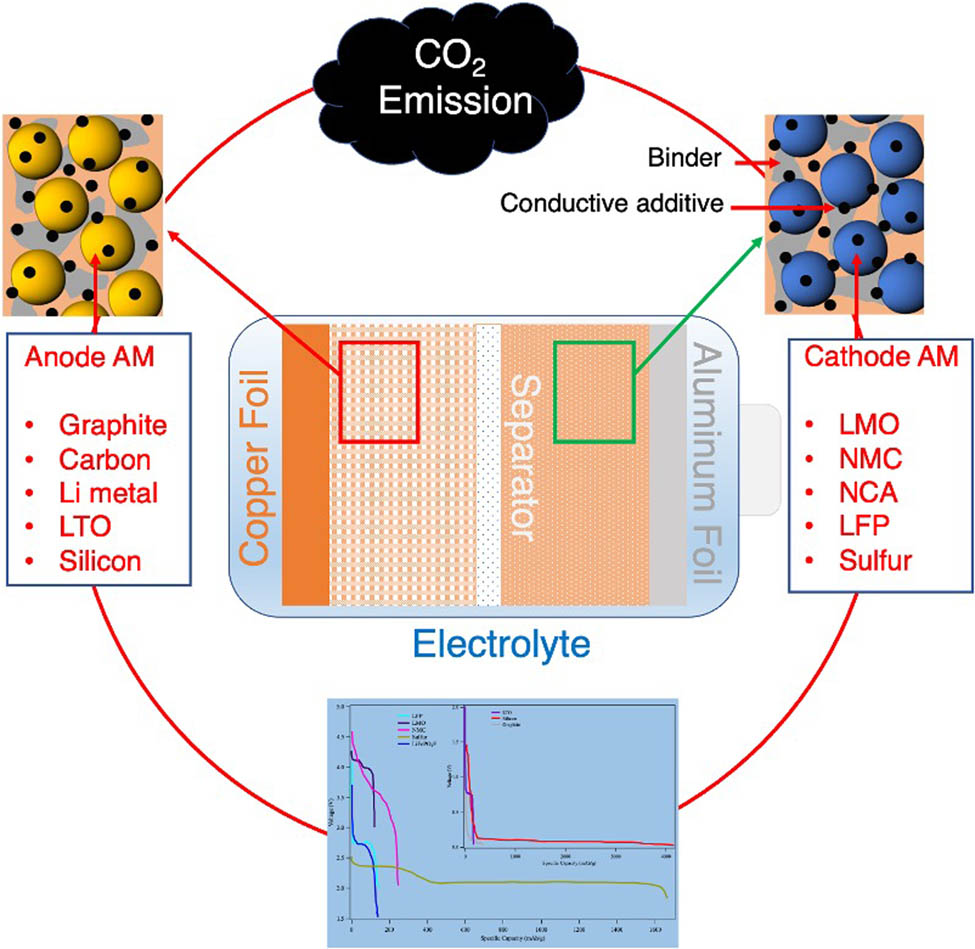| Dec 01, 2021 | |
Strategies for improving rechargeable lithium-ion batteries |
|
| (Nanowerk Spotlight) One of the greatest environmental concerns in the near future is anthropogenic global warming caused by man-made carbon emissions. Electric vehicles (EVs) have received much attention as a new way of transportation with lower CO2 emissions. | |
| The high efficiency of electric motors and the ability to generate electricity from low-carbon sources is expected to reduce CO2 emissions through the use of EVs. | |
| However, electric cars have been criticized in recent times due to their energy-intensive manufacturing processes and the fact that many EVs are currently charged using electricity which is partly produced from fossil fuels. | |
| Prof. Ramakrishna Podila’s group at Clemson University recently published an invited review article in Nanotechnology Reviews ("Strategies for improving rechargeable lithium-ion batteries: from active materials to CO2 emissions") addressing this issue. In addition to reviewing the advances in new battery chemistries, they presented new insights into CO2 emissions from battery manufacturing. | |
 |
|
| Graphical abstract of the work. (De Gruyter, Published under 4.0 International, CC BY 4.0) | |
| “There are many unanswered questions about the life-cycle greenhouse gas implications of electric vehicles, especially related to early estimates of battery production emissions,” said Dr. Ramakrishna Podila, Associate Professor of Physics at Clemson University and the corresponding author of the study. | |
| EV manufacturing requires more energy and produces more emissions than manufacturing a conventional car because of batteries. Li-ion battery production requires energy-intensive processes such as extracting and refining rare earth metals. The battery manufacturing emissions are not same for all battery chemistries and materials. | |
| Battery materials that provide highest energy and power density are not necessarily the most environmentally friendly. Indeed, some highly used battery materials in Li-ion battery (e.g., doped and undoped lithium cobalt oxide) result in a significant increase in manufacturing emissions. | |
| “Some battery materials are more environmentally friendly than others. For example, lithium iron phosphate (LFP) produces less emissions than nickel manganese cobalt (NMC) oxide,” explains Dr. Shailendra Chiluwal, the lead author on the review. “Even within the same material type, say NMC, the net emissions from battery manufacturing are different based on the method used.” | |
| While the research in advanced batteries continues to rapidly grow, there has been little emphasis on the impact of materials choice and synthesis methods on battery manufacturing emissions. In this regard, the review article proposes a new metric in addition to traditional energy and power density viz., CO2 emissions/kWh for the specific battery material, chemistry, and architecture. | |
| “High-impact journals should seriously consider possible changes in CO2 emissions from proposed battery designs,” said Podila, “Indeed, battery manufacturing emission estimates should be made an important part of peer-review in order to better identify environmentally friendly materials rather than focusing solely on energy and power density with complete disregard for manufacturing emissions.” | |
| The review article also shows how battery manufacturing emissions are also strongly dependent upon geographical location. Most Li-ion batteries in EVs are produced in countries other than USA, where approximately 25%–40% of electricity generation is from coal with high CO2 emission (~1.3-1.7 lbs of CO2/kWh compared to the US average of 0.75 lbs of CO2/kWh). | |
| EVs travel farther with a given amount of energy and account for fewer emissions through the fuel production and vehicle use phases. Overall, EVs have lower life-cycle greenhouse gas emissions than a typical car in US, even when assuming relatively high battery manufacturing emissions. | |
| However, when battery manufacturing emissions are higher, it takes longer time for EVs to offset the net emissions. A typical mid-size EV presently takes about 1-2 years of driving to offset manufacturing emissions in the United States. Adapting new battery materials or chemistries that increase manufacturing emissions is likely to increase the time for such an offset. | |
| This new review article makes it clear that although the manufacturing of batteries does not outweigh the life-cycle environmental benefits of electric vehicles, these emissions are nonetheless substantial. | |
| Provided by Clemson Nanomaterials Institute as a Nanowerk exclusive | |
|
Become a Spotlight guest author! Join our large and growing group of guest contributors. Have you just published a scientific paper or have other exciting developments to share with the nanotechnology community? Here is how to publish on nanowerk.com. |
|
